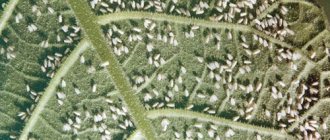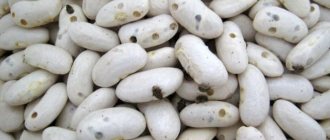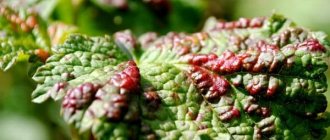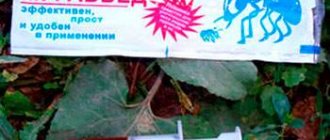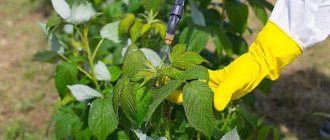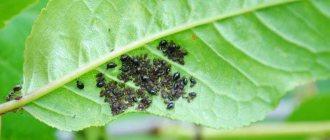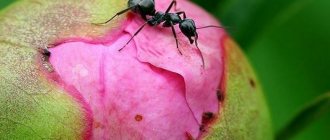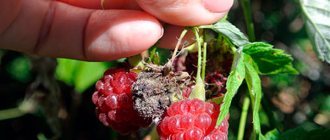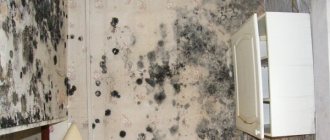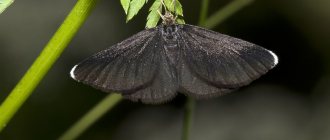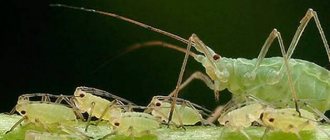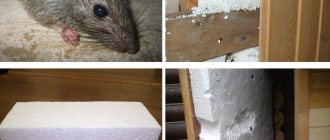Every experienced gardener knows that if aphids appear on a cherry tree, then urgent measures must be taken to destroy it. Otherwise, this small pest can cause serious damage to the tree, which will lead to a significant reduction in yield. After all, aphids are characterized by increased fertility and form numerous colonies in a short time. And in the absence of control measures, it is capable of moving to neighboring crops.
Aphids belong to the order Homoptera
Description and types of aphids
There are more than 5 thousand species of aphids in nature. But only some of them attack cherries. They are similar in many ways. But they also have certain differences.
Gall aphids on cherries
This pest is characterized by an ovoid body shape, the length of which reaches 2 mm. The color of gall aphids is greenish-yellow. There are small sparse hairs on her body. Peak pest activity is June. During the season it forms 3-20 generations. Favorable conditions for development are elevated air temperatures.
When affected, swellings called galls appear on the leaves of the cherry tree, which is why this species got its name. They appear when the tree tries to repair damaged tissue.
Aphids belong to the order Homoptera
Green aphids on cherries
This is a small insect with an oval body. Characterized by a dark green color. Aphids overwinter in the egg stage. Adults die when the temperature drops. Pest colonies are localized at the tops of young branches. And black eggs are laid at the base of buds and shoots. In the second generation, female settlers appear. Their function is to fly to neighboring crops for the purpose of reproduction.
Green aphids are activated by high humidity and high temperatures. Up to 19 generations of the pest can appear during a season.
Each female green aphid lays no more than five eggs at a time
Black aphids on cherries
The difference between this species is its black color. The pest has an ovoid body, ranging in size from 0.5 to 2 mm. Females are wingless and winged. The first ones appear at the beginning of the season from the overwintering clutch of eggs. The second - in the middle of summer. You can find a colony of black aphids on the back of cherry leaves.
Black aphids attack all stone fruits in the garden
Fighting methods
Aphids on tomato seedlings - how to fight
If black aphids are found on cherries, how to fight them? There are different methods:
- biological - using insects, birds, plants;
- physical – with the installation of special devices;
- folk - using home remedies;
- chemical - through chemicals.
Important! Colonies of black aphids will repeatedly attempt to invade cherry trees and other garden plants. Constantly treating cherries with chemicals is a rather dangerous undertaking, since there is a high probability of toxic substances entering the human body. It is better to first try safer ways to get rid of aphids from cherries.
Biological methods
Plants
You can protect cherries and prevent the appearance of aphids with the help of plants:
- Plants that repel pests with their phytoncides: marigolds, coriander, onions, garlic, lavender, mint, fennel. They are planted close to the cherry trees;
- Plants that attract aphids: petunia, nasturtium, cleome, mallow, poppy, cosmos, beans, bird cherry, linden, viburnum. They should be as far away from the cherry as possible, distracting the pest. Once affected by aphids, these plants will have to be removed from the site or sprayed.
Insects
Aphids have natural enemies in nature that eat them: hoverflies, ladybird larvae, ground beetles, lacewings, earwigs, ichneumon wasps, predatory bugs and others. It is beneficial for the gardener to attract them to his plot. Hoverflies fly in to collect pollen from blooming daisies. Their larvae eat huge quantities of black aphids. Solanaceae and amaranth serve as bait for ground beetles; thickets of fern will attract lacewings. Earwigs can be lured with containers of wood shavings. Ladybird and lacewing larvae are also sold in garden centers.
Insects
Birds
If you do not plan to use chemicals, birds will help fight black aphids. Feeders and water containers will attract sparrows, tits, wrens, linnets, chiffchaffs, willow warblers, wrens, and robins.
Physical methods
The simplest way to combat aphids and ants is to wash them off the cherry tree with a strong stream of water. This is done early in the morning, before the heat sets in, otherwise the plant will get burned. Some gardeners try to remove pests by crushing them with the palm of their hand in accessible places, cutting off infected shoots, leaves and inflorescences. But doing this manually is technically very difficult and ineffective, so you have to resort to other methods:
- using special trapping belts for the cherry trunk, wrapping it with strips of adhesive tape;
- weed control;
- pouring boiling water over nearby anthills;
- planting peppermint, garlic, and tomatoes next to the cherries, as their smells repel ants.
If ants are still found on cherries, how to get rid of them? Sprinkle bleach around the cherry. This will become an insurmountable barrier for ants, and aphids will not settle on this tree.
Folk remedies
There are effective, proven by many gardeners, folk methods of combating black aphids on cherries. For example, the use of herbal infusions and decoctions. Cherries can be processed in the summer - in June and July.
Note! Despite the safety of infusions and decoctions of plants, it is worth remembering that exceeding the recommended concentration of herbal remedies in some cases can cause burns on cherries.
Such products can pose a danger not only to harmful, but also to beneficial insects. Some of them can cause poisoning in humans. Therefore, it is necessary to strictly observe the required proportion.
Garlic infusion
The following recipe has a good insecticidal effect against black aphids:
- chop a bunch of herbs and garlic roots;
- add 5 liters of water, a grated piece of soap;
- leave for 1 to 2 hours.
Areas infested with black aphids should be sprayed 3 times every 10 days.
Garlic infusion
Ash and water
Wood ash needs to be sifted. Take 300 g (2 cups) of ash and boil it in several liters of water for half an hour. After this, add enough water to make 10 liters of product. The cooled liquid is sprayed onto the cherries. After 10 days, the procedure must be repeated.
Another recipe against aphids. Pour 10 liters of boiling water over 300 g of ash, add 50 g of laundry soap crushed into shavings. After overnight infusion, the solution is filtered through a triple layer of gauze and poured into a sprayer. Cherry processing is carried out at the stage of bud bursting and the appearance of young leaves.
Tomato leaves
Take 5 kg of green tops and tomato shoots, pour 10 liters of hot water, boil for half an hour over low heat. Before spraying the cherries, the broth is diluted with water in a ratio of 1:3 and 30 g of soap is added per 10 liters.
Tomato leaves
Celandine
For a 10-liter bucket of water you will need 3-4 kg of freshly collected celandine. You need to insist for at least 2 hours in a dark place. Cherries should be treated with infusion daily until results are obtained.
Dandelion
About 300 g of finely chopped fresh dandelion leaves are poured into 10 liters of warm water. The infusion takes 2 days to prepare. The product must be filtered before use.
Onion peel
The infusion is made from 500 g of onion peel and 10 liters of water. Cherry trees are sprayed every 10 days.
Tobacco
A concentrate is prepared from 200 g of tobacco and 1 liter of water. Before use, it is diluted with water in a ratio of 1:3.
Another folk recipe against aphids with tobacco: 200 g of finely chopped dry tobacco leaves are poured into 5 liters of water. After 1 day, the resulting infusion should be diluted with water to 10 liters and boiled over low heat for 1.3 to 2 hours.
Tobacco
Essential oils and cream
Essential oils of lavender, cedar and tea tree are diluted in a glass of cream - 10-15 drops each. The mixture is diluted with 2 liters of water. 3 procedures of spraying cherries every other day are enough.
Vinegar
You cannot use vinegar in its pure form, as this will burn the plant. A solution of 1 tsp. vinegar and 1 liter of cool water is highly effective against aphids on cherries. If apple cider vinegar is used, then take 1 tbsp. for 1 liter of water. It is recommended to enhance the effectiveness of the solution by adding any detergent. It makes it difficult for aphids to move, preventing the insect from escaping. Spraying the product on cherries is carried out at intervals of 2-3 days.
Soda Ash
To get rid of not only black aphids, but also powdery mildew, you will need:
- soda ash - 2 tbsp. l.;
- dishwashing liquid – 1 tbsp. l.;
- water – 1 l.
Cherries need to be processed several times, with an interval of 5 days. The product can be used even during fruit ripening.
Cherry processing
Domestos and soap
To 10 liters of water add 100 g of tar soap (you can use black laundry soap) and 5 drops of Domestos or another chlorine-containing product. It is necessary to spray the solution on the cherry branches after the leaves bloom. After 15 minutes, rinse the treated areas with water from a hose. After 2 days, the procedure is repeated.
Ammonia
Instant action recipe, no need to rinse off. A couple of tablespoons of ammonia are dissolved in a bucket of water, 1 tbsp is added. l. liquid soap.
Chemical methods
There are 3 classes of insecticides against black aphids:
- Pyrethroids: Kinmiks, Decis Profi, Inta-Vir;
- Organophosphorus compounds: Actellik (pirimiphos-methyl), Karbofos, Antiklesch, Alatar, Fufanon. Currently, these agents are becoming less effective as aphid resistance is observed;
- Neonicotinoids: Aktara (thiamethoxam), Confidor (imidacloprid), Tanrek, Iskra Zolotaya. These are the most effective remedies against aphids. Analogues of these drugs: Biotlin, Komandor, Zubr, Prestige, Imidor, Tsvetolyuks Bau, Kalash, Corado, Respect, Monsoon, Tabu and others.
Insecticide against black aphids
The use of chemicals requires compliance with the correct time for spraying. Suitable periods for processing cherries:
- branches before the leaves open;
- before flowering begins, when budding occurs;
- at the end of flowering, during the growth of the ovaries;
- a month before picking berries.
If you treat cherries with a chemical agent against aphids during flowering, toxic substances will enter the berries.
There are also biological products: Fitoverm, Akarin. They do not accumulate in plant leaves, and 4 hours after application they become harmless to bees. But there are also disadvantages. Constant use of these products causes the formation of resistant strains; spraying can only be done in cool weather (18-20 degrees), a small degree of toxicity is still present.
Where do aphids come from on cherries?
Winged females, which appear in late June and early July, are responsible for the spread of the pest. Their function is to lay eggs on trees. Of these, wingless females subsequently emerge that are capable of reproducing without fertilization. They are the ones responsible for preserving the species. In the fall, all adult individuals and larvae of aphids die, and only the eggs of the pest remain over the winter. With the arrival of spring, the aphid life cycle resumes.
Ants also contribute to the spread of aphids in the garden. Because they feed on the product of its vital activity - copper dew. In winter, ants transfer aphid eggs to an anthill for preservation, and with the arrival of spring, they lift them onto cherry tree branches to ensure adequate nutrition for the larvae after they are born.
Important! Aphids primarily attack weakened cherries that are unable to withstand the invasion of the pest.
Favorable temperature conditions
The massive appearance of black cherry aphids and insect larvae directly depends on the climate. Air temperature is of decisive importance for their reproduction and feeding intensity. Optimal temperature conditions are +25 C; in hotter weather, activity decreases, and at an average daily temperature below -6 C, the pests die.
What does aphid look like on cherries?
It is quite difficult to identify a lesion at the initial stage. But as the colony grows, signs of aphids on the cherry become obvious.
Among them:
- leaf deformation;
- sticky coating on shoots, plates;
- drying out of young branches;
- shedding of the ovary;
- premature leaf fall;
- slow development of cherries;
- reduced fruit size.
The reason for a thorough inspection of the trees in the garden should be ants scurrying everywhere.
Preventive action
To avoid having to treat cherries for pests, you need to take some preventive measures. The following measures will help protect plants:
- Regular weeding. Removing weeds allows you to interrupt the reproductive cycle of black aphids, since the hatching of new generations occurs during the phase of colonies spreading throughout the territory.
- Preventative examination. Regular plant inspections allow you to detect the presence of pests at an early stage, when it is easy to stop their spread.
It is also recommended to make cone-shaped traps on the cherry tree, which will prevent insects from climbing above the protected level.
An interesting way to protect cherry and sweet cherry trees is to attract natural enemies of black aphids to the garden. Umbrella plants, lavender, and fragrant thyme attract ladybugs and hoverflies, which happily eat aphids. Please note that these insects are not pests, but are excellent helpers in the fight against cherry pests.
What harm does
Aphids feed on the cell sap of leaves and young shoots of cherry trees. This leads to disruption of metabolic processes in tree tissue, which negatively affects its development. As a result, the resistance of cherries to unfavorable external factors decreases. This is especially dangerous for young seedlings, since low immunity leads to their death in winter.
Aphids are carriers of various diseases. The most common of them is sooty fungus. It is characterized by a thick black coating on the surface of the leaves. When it appears, the process of photosynthesis is disrupted. As a result, cherries experience a deficiency of nutritional components. Also, sooty fungus is a favorable environment for the development of bacteria, viruses, and infections.
When aphids are infested, the taste of cherry fruits decreases
Banishment by smell
To repel pests, you can use plants, flowers, and strong-smelling substances.
- You can treat cherries against ants and aphids with garlic juice. Use the head or arrows of a winter plant. It is necessary to rub the trunk around. The persistent smell of garlic will scare off new pests and make established ones flee.
- Twigs of wormwood and tansy are tied around the trunk. The plants are absolutely safe for the tree; they not only repel ants, but also cause toxicosis. It is necessary to prepare a tincture from these plants and coat the cherries. Pour 30 g of dry potion, 300 g of fresh flowers and 10 liters of water. They insist for a day. You can prepare a more concentrated composition, the cherries will not be harmed.
- Cotton wool and wool are soaked in carbolic acid and tied with a belt around the trunk of the cherry tree. Removed after 3 days. Repeat the procedure several times until the ants' interest in cherries disappears.
Insects cannot tolerate the smell of anise, elderberry, peppermint, calendula, cloves, and tomato tops. These components can be used to construct belts, lay them around cherries, scatter them throughout the area, or grow plants in the garden. The protection lasts as long as the smell persists.
Morphology
Polymorphism. The life cycle of the species consists of several morphologically different generations:
- Foundress, emerges from an egg. Wingless.
- Asexual virgin – several spring-summer generations of parthenogenetic females: Winged virgin.
- Wingless virgin.
All parthenogenetic generations of cherry aphids, like all representatives of the superfamily of true aphids, are viviparous.
The egg is shiny black, elongated oval in shape.
Founder. Body length – 2.0–2.4 mm. The body shape is broadly pear-shaped. The integument is black and shiny above, brownish below. The tubes are cylindrical, black, slightly tapering towards the apex. The antennal tubercles are high and form the frontal groove. The antennae consist of five segments. The tail is triangular.
Wingless virgin. Body length – 2.0–2.4 mm. In appearance she resembles the founder. The antennae consist of six segments. The tubes are twice as long as the tail. The abdomen is sclerotized and pigmented. The color of the integument is brown-green, black-green, black.
Winged virgin. Body length – 2.4 mm. The color of the cover is black, shiny. Antennae with six segments. The third segment contains 14–20 secondary rhinaria.
Normal female (amphigonic). Body length – 1.6 mm. The body shape is oval. There are no wings. Antennae with six segments. The hind tibia is thickened and has from 10 to 70 false sensoria.
Signs of defeat
Aphids feed on plant sap, and to do this they attack the succulent parts of stems and leaves. Thus, the leaves begin to curl and do not participate in photosynthesis. The tops of the shoots begin to wither. Trees that have been exposed to aphids do not grow fully, do not tolerate winter well, and often succumb to fungal diseases.
Black or cherry aphids develop very rapidly. Sometimes its occurrence comes as a complete surprise to the gardener. Over a period of several days, the shoots can be practically strewn with dark, swarming dots. These are aphid eggs that are ready for winter. It is also worth finding out more about dark aphids, how they look on cucumbers and how you can fight them.
Does hydrogen peroxide help?
Another common pseudoscientific theory is that cancer is caused by a toxin, and hydrogen peroxide helps neutralize this toxin. For cancer patients, this “miracle drug” is suggested to be drunk and even injected into a vein.
Indeed, contact with various toxins can lead to cancer. But this is only one of many risk factors. There are also viruses, heredity, physical influences (for example, UV rays), aging of the body and disruption of the immune system.
Cancer is a multifactorial disease. Its causes cannot be reduced to one toxin. There is no evidence that hydrogen peroxide helps destroy cancerous tumors. Taking it orally is dangerous, and even more dangerous is injecting it into a vein.
Homeopathy against cancer
The essence of homeopathic treatment is described by two principles:
- Like cures like. Diseases are supposedly helped by low doses of substances that, in high doses, cause symptoms of the disease. For example, homeopathic caffeine is a remedy for insomnia.
- All homeopathic medicines are used in large dilutions. To the point that not a single molecule of the active substance should remain in the solution.
These principles contradict the laws of physics and chemistry. Homeopathy is unscientific, there are studies that prove that such drugs work no better than dummy placebos. This does not stop some homeopathic doctors from claiming that they can cure cancer.
How dangerous is a garden guest?
The pest leaves waste products on the leaf blades - secretions from carbohydrates and excess water. The sugary substance is called honeydew. It covers the leaf blade, preventing normal photosynthesis. The leaves become a target for the fungus. In addition, a colony with aphids is a carrier of viral diseases. As a result, severe damage is caused to the plant.
Spraying as a control method
To remove aphids, a whole range of agrotechnical measures is required. Among them are competent crop care, preventive measures and the direct phased destruction of colonies using chemical, biological and folk methods.
Prevention
To prevent aphids from attacking the cherry, preventive measures are carried out. Trees protect against ants, which spread pests to fruit crops. To do this, in early June, a sticky belt or a foil skirt is put on the trunk.
We must not forget about the following preventive measures:
- The plant should be provided with good watering and fertilizing.
- Near the trunk it is worth removing all the weeds and sowing marigolds and tansy.
- It is necessary to remove nests of garden ants from the area.
- Trees should be constantly inspected.
- Mulching must be used. Celandine, mint, and wormwood are suitable for this purpose.
It is not only the green crowns that need to be monitored. Small aphids move to cherries from any other crop. In early spring and autumn, it is necessary to remove old bark and whiten tree trunks. This will protect them from insects and rodents.
Dealing with aphids on cherries is easy, but you need to choose the right remedy. Chemicals can quickly kill aphids, but they should not be used on cherries during the flowering period. In this case, folk recipes will help out. Control measures include prevention.
Reasons for appearance
It is much easier to get rid of ants on trees if you understand the principle and features of their life activity. Insects belong to the category of social insects. They have an organized social system. Each individual performs certain labor duties, deviation from which causes the entire colony to fail.
Most ant species organize their lives according to a certain pattern. One anthill can contain more than a million individuals. The main thing in the settlement is the queen. After the elimination of which the colony dies. Red ants have several queens, so it is more difficult to fight ants in the garden and on fruit trees.
The reason for the appearance of insects of all types is the search for food. The garden and vegetable garden are an ideal place for the anthill to obtain food. Since settlement occurs in the spring, they can appear on the site due to:
- the presence of last year's plant debris or accumulated over the winter;
- manure heap and other natural fertilizer mixtures;
- seeds, insects that remained under the bark of trees and shrubs.
The scout ant explores the new territory and leads the others to it. It is not always possible to discover the location of an anthill right away. Ants live not only on the ground, but also in hollows, roots of trees or bushes, under the bark.
Insurmountable obstacles
Ants can crawl through the smallest cracks and climb to the very top of a tree, but you can outwit them.
- In early spring, a small ditch is dug around each tree and a cut tire is placed there. Add droplets from all sides and fill with water. Ants and many other garden pests will not be able to cross a water ditch.
- The cherry trunks are tied with a polyethylene belt. Birch tar is smeared on top of it. Resin and grease also help against aphids.
- A clothesline is coated with Vaseline and tied onto a cherry.
- A “skirt” is formed from foil, which is widened towards the top. It is difficult for ants to climb on a slippery base, but if this happens, the skirt, widened upward, will prevent the pests from reaching the trunk and branches of the cherry.
- Cherry trunks are coated with lime and chalk is sprinkled around the tree. Calcium has a beneficial effect on the growth and development of cherries and prevents ants from climbing the trunk. Small particles stick to the paws, making it impossible to firmly cling to the bark. Protects lime from aphids.
Biological drugs
Biological preparations
If you need to treat a tree with berries, then you should use biological preparations. They do not harm the fruits and flowers of the plant. The aphids will die if you spray the cherries with the following products:
- Fitoverm product;
- Aktarin;
- drug Iskra.
Spraying of plants is done even before harvesting. The preparations are completely harmless to beneficial insects and the human body.
Is it possible to protect the bushes
Traditional recipes are effective and harmless to humans, plants and animals. But they are not able to remove the threat from a strong attack of ants. Experienced gardeners often recommend using several protection options at the same time: herbs + spraying with infusions + belts or a barrier method. In any case, such armor will not allow the ant to enter the bush.
Important! If you don’t want to check the accuracy and effectiveness of folk recipes, you can always turn to chemicals.
Varieties
In the garden you can find only two types of ants: red and black. The habitat of the species is considered to be the entire territory of Eurasia to northeast China. Central Siberia is attacked only by black ants.
Redheads
They live in places where people are constantly present. The vegetable garden is not the best area for this type of ant. They prefer to settle near human habitation, but, of course, they will not refuse the juicy fruit of a pear or apricot. The colony settles in cracks under the house and grows quite quickly. Difficulties in etching them arise due to the presence of several queens. Accordingly, there are the same number of nests. Their moves unite. The lifespan of the uterus is up to 15 years. The speed of nest detection means peace of mind for the gardener.
Garden black
The color of the individual depends on the type of soil: from black to light yellow. There are also gray and brown ones, but the color does not affect the methods of destruction, because they are usually the same. Ants thrive on all types of soil. They survive in any conditions; temperature and climate do not affect the appearance of black garden ants.
TOP 15 best remedies for garden ants
In addition to the garden and vegetable garden, where the species feels good, the anthill can move into the house. The reason is fertility. Life expectancy is up to 28 years. They build their homes in the following places:
- soil (reaches 1 m deep);
- hollows;
- rotten wood;
- under stones;
- under the foundation of the house.
